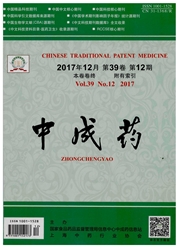

 中文摘要:
中文摘要:
尽管有他们质量的巨大的差别,大多数不同来源的草药的药在诊所被用于一样的治疗目标。因为临床的功效是仔细与药的质量有关,有效质量控制(质量管理) 的实现过程是重要的。基于内容,决心和色析法的指纹(CF ) 被推荐了为强大的工具的化学方法。尽管有在质量管理的进展,决定那仍然是困难的其作文能最好反映的化学药品与需要的生物活动的关联。此处,我们在多来源的生物活动集中了草药的药建立一个分析方法。由寻找在生物活动和他们的化学作文之间的关联,方法能与生物活动信息识别合理化学指示物或化学方法。在这研究,高效的液体层析(HPLC ) 和 microcalorimetry 为从不同来源评估根茎 coptidis 的质量作为一个有用方法被联合。生物指纹(BF ) 的结果证明抗菌剂活动 R 定序。不同来源的 coptidis 是黄连属 teeta 墙。(CT )> 黄连属 chinensis Franch。(CC )> 黄连属 deltoidea C.Y Cheng et Hsiao (CD ) 。在 CF 和 BF 之间的光谱活动关系用正规关联分析(CCA ) 被调查。与 CF 和 BF 的 CCA 结果相比,正规关联系数 r 1 并且 r 2 分别地是 0.9974 和 0.9752。它表明在光谱活动关系之间有靠近的关联,包括 jatrorrhizine, coptisine,巴马亭,和 berberine 并且在 CF 的几个主要抗菌剂部件。当然, R。coptidis 仅仅是多来源的一个代表医药植物。当前的学习的结果将为评估多来源的质量提供一本有效参考书草药的药。
 英文摘要:
英文摘要:
Most of herbal medicines of different sources are used for the same treatment goal in clinic despite their tremendous differ- ences of the quality. Because the clinical efficacy is closely related to the quality of medicines, the implementation of an ef- fective quality control (QC) process is vital. Chemical methods based on content determination and chromatographic finger- prints (CFs) have been recommended as powerful tools. In spite of advances in QC, it is still difficult to determine that which of the chemical compositions can best reflect the correlation with the desired biological activity. Herein, we have focused on the biological activities of multi-source herbal medicines to establish an analytical method. By looking for correlations be- tween the biological activities and their chemical compositions, the method can identify reasonable chemical indicators or chemical methods with biological activity information. In this study, high-performance liquid chromatography (HPLC) and microcalorimetry are combined as a useful method for evaluating the quality of Rhizoma coptidis from different sources. The results of biological fingerprints (BFs) showed that the antibacterial activity sequence of R. coptidis of different sources was Coptis teeta Wall. (CT)〉Coptis chinensis Franch. (CC)〉Coptis deltoidea C.Y. Cheng et Hsiao (CD). The "spectrum-activity" relationships between CFs and BFs were investigated using the canonical correlation analysis (CCA). Compared with the CCA result of CFs and BFs, the canonical correlation coefficient r1 and r2 were 0.9974 and 0.9752, respectively. It revealed that there are a close correlation between the spectrum-activity relationships and several of the major anti-bacterial components in the CFs, including jatrorrhizine, coptisine, palmatine, and berberine. Of course, R. coptidis was only a representative of multi- source medical plants. The result of the current study will provide an effective reference for evaluating the quality of multi
 同期刊论文项目
同期刊论文项目
 同项目期刊论文
同项目期刊论文
 期刊信息
期刊信息
